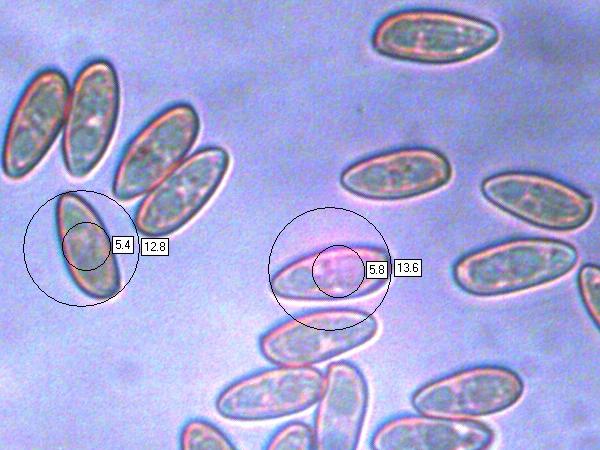Suillellus luridus (Schaeff.) Blanco-Dios - Lurid Bolete
Phylum: Basidiomycota - Class: Agaricomycetes - Order: Boletales - Family: Suillaceae
Distribution - Taxonomic History - Etymology - Identification - Culinary Notes - Reference Sources
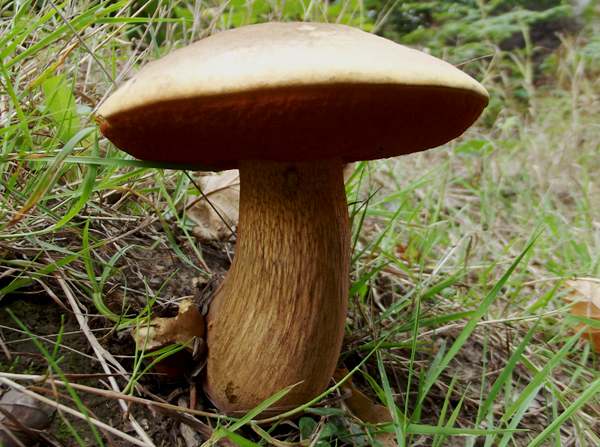
Boletus luridus is found under beech, lime and oak trees, mainly in areas of chalky soil. It is sometimes mistakenly identified as Suillellus satanas, which is known to be poisonous, but the very pale lumpy cap of Rubroboletus satanas distinguishes it from the Lurid Bolete.
This is one of the many reddish boletes that undergo a colour change when bruised or cut. In this instance the pallid flesh turns rapidly blue-black on contact with the air.

Distribution
Boletus luridus var. luridus (the autonomous or originally defined form of Boletus luridus) is fairly frequent throughout Britain and Ireland as well as on mainland Europe; it occurs most often in areas where the soil is alkaline.
Taxonomic history
Suillellus luridus var. luridus was first described as Boletus luridus in 1774 by the German botanist-mycologist Jacob Christian Schaeffer, and was generally accepted by the original name that Schaeffer had given it until 2015, when other varieties of this species were formally described by Spanish mycologist J. B. Blanco-Dios; then the autonomous form took the name Suillellus luridus var. luridus (Schaeff.) Murrill after a 1909 publication by American mycologist William Alphonso Murrill (1869 - 1957).
The darker-capped (and rare in Britain) variety Suillellus luridus var. rubriceps (Maire) Blanco-Dios was first described in 1937 by the famous French mycologist René Charles Joseph Ernest Maire (1878 - 1949); it is synonymous with Tubiporus luridus var. rubriceps Maire.
Synonyms of Suillellus luridus var. luridus include Boletus luridus Schaeff., Boletus rubeolarius Bull., Leccinum luridum (Schaeff.) Gray, and Leccinum rubeolarium (Bull.) Gray.
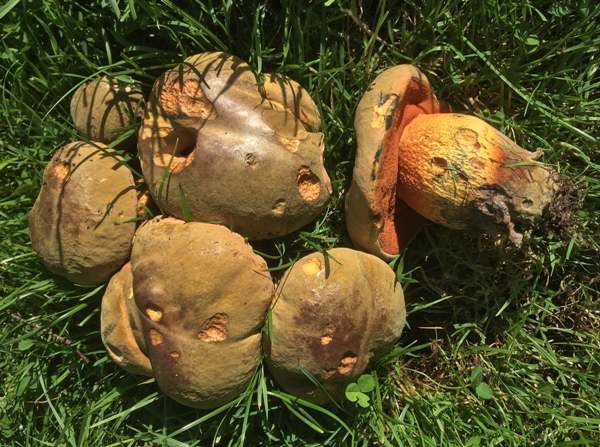
Etymology
The generic name Boletus comes from the Greek bolos, meaning 'lump of clay', while the new genus name Suillellus may perhaps imply a relationship with the genus 'Suillus' - Suillus means of pigs (swine) and is a reference to the greasy nature of the caps of fungi in that genus (but not of the genus Suillellus)... confused? Me too. The specific epithet luridus means 'sallow' - an indefinite but unhealthy colour.
Identification guide
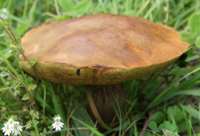 |
CapImmature specimens, such as the Lurid Bolete shown at the top of this page, are downy and pale yellow. As the fruiting body matures, the cap, which usually expands to between 8 and 14cm (exceptionally to 20cm) in diameter, becomes dull yellow-brown. The yellow cap flesh of Boletus luridus turns blue-black if it is cut or bruised. Once you cut through a cap you will see that a deep wine-coloured line appears separating the pores from the rest of the cap context (the fleshy material below the surface skin) - an unusual feature in a bolete and yet another aid to identifying Boletus luridus. |
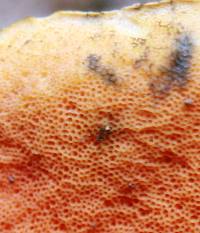 |
Tubes and PoresBeneath the cap, yellow spore tubes terminate in tiny circular pores that are at first yellow but eventually turn orange-red. When cut or bruised, the tubes and pores rapidly turn blue-black before fading to pale blue. |
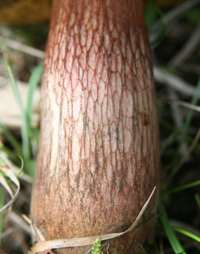 |
Stem1.5 to 4cm in diameter and 5 to 10cm tall, the underlying surface of the stem is yellow, covered with a red mesh patterning everywhere except for the top part of the stem, which remains yellow. |
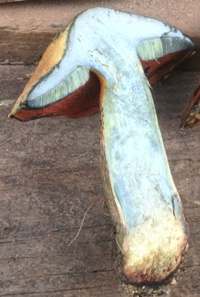 |
The swollen stem of a Lurid Bolete turns dark blue when cut and then fades back to a light blue colour. The flesh near the base of the stem is deep yellow with red tinges. (See picture left, which is kindly contributed by Simon Harding.) Unusually for a bolete, the mycelial threads at the base of the stem are yellow rather than white - another helpful identifying feature, but only visible if you pull the bolete from the ground rather than leaving it for others to enjoy. It's perhaps something worth seeing once rather than repeating every time you find a Lurid Bolete. |
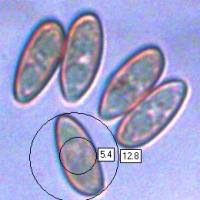 |
SporesSubfusiform to broadly ellipsoidal, smooth, 11–15 x 4.5–6.5µm. Spore printOlive-brown. |
Odour/taste |
Not distinctive. |
Habitat & Ecological role |
Suillellus luridus is most commonly found under beech trees on calcareous soil. This ectomycorrhizal species is also sometimes seen beneath oak trees and very occasionally under limes. In The Burren, in southwest Ireland, I have seen Lurid Boletes growing with the lime-loving shrub Mountain Avens (Dryas octopetala), with which it is believed to form a mycorrhizal association. |
Season |
July to late October in Britain and Ireland. |
Similar species |
Rubroboletus satanas, a poisonous species, has a very swollen stem covered in a deep red net pattern on a yellow background, and it has a chalky-white cap. Neoboletus luridiformis, the Scarletina Bolete, has a less swollen stem than that of Suillellus luridus, and its stem is covered in tiny red dots rather than having a reticulate (net-like) pattern on the stem as does the Lurid Bolete. |
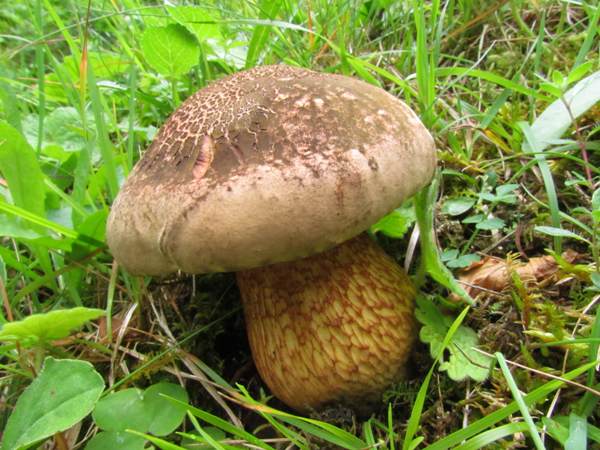
On mainland Europe, Suillellus luridus sometimes has a cracking cap (Slovenia).
Culinary Notes
Suillellus luridus is generally considered edible only if cooked thoroughly; however, as it can be confused with poisonous boletes such as Rubroboletus satanas great caution is advised. (These mushrooms turn black when cooked, and the appearance of such a meal may be off putting to some people.)
Above: This bolete, found in Slovenia, matches the micro and macro characters for Suillellus luridus, but it has an atypical crazed cap. Some authorities classify red-capped forms of the Lurid Bolete as Suillellus luridus var. rubriceps.
The cause of the damage to the cap of the Lurid Bolete shown below is very clear: a small rodent has been tucking in to a tasty meal and left its tell-tale teethmarks. This specimen was found in limestone grassland on The Burren, in Ireland.

Reference Sources
Fascinated by Fungi, 2nd Edition, Pat O'Reilly 2016, reprinted by Coch-y-bonddu Books in 2022.
British Boletes, with keys to species, Geoffrey Kibby (self published) 3rd Edition 2012
Roy Watling & Hills, A.E. 2005. Boletes and their allies (revised and enlarged edition), - in: Henderson, D.M., Orton, P.D. & Watling, R. [eds]. British Fungus Flora. Agarics and boleti. Vol. 1. Royal Botanic Garden, Edinburgh.
Dictionary of the Fungi; Paul M. Kirk, Paul F. Cannon, David W. Minter and J. A. Stalpers; CABI, 2008
Taxonomic history and synonym information on these pages is drawn from many sources but in particular from the British Mycological Society's GB Checklist of Fungi.
Acknowledgements
This page includes pictures kindly contributed by Geoff Dann and Simon Harding.
Fascinated by Fungi. Back by popular demand, Pat O'Reilly's best-selling 450-page hardback book is available now. The latest second edition was republished with a sparkling new cover design in September 2022 by Coch-y-Bonddu Books. Full details and copies are available from the publisher's online bookshop...
